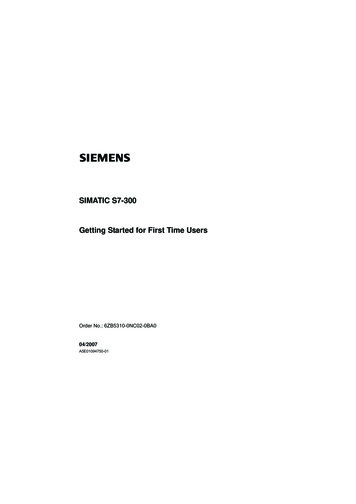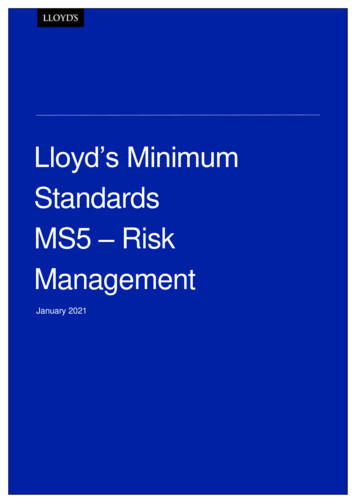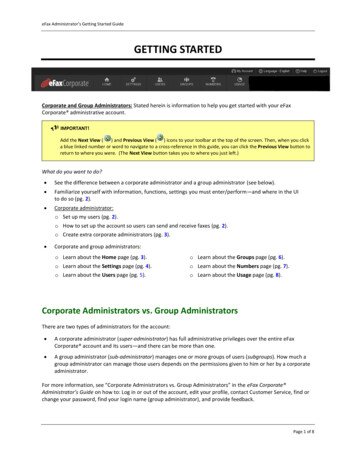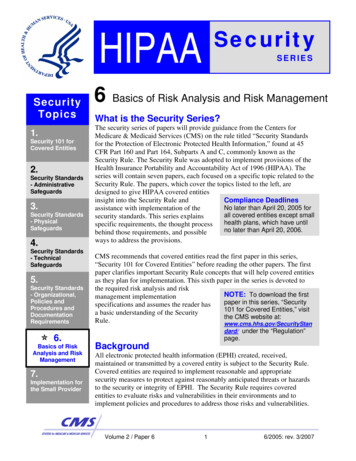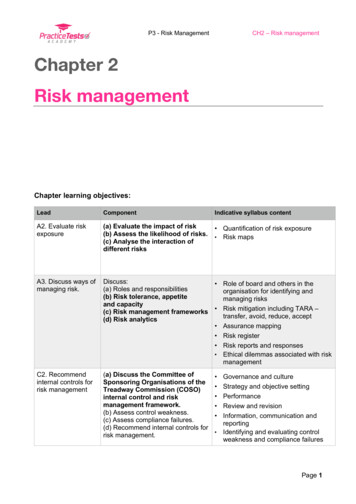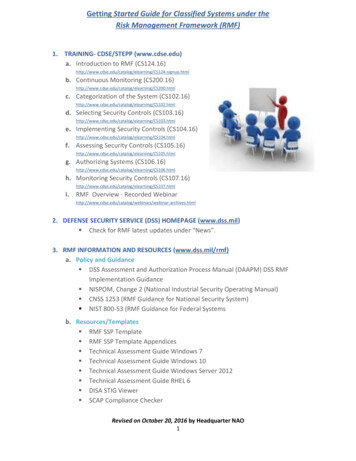
Transcription
Getting Started Guide for Classified Systems under theRisk Management Framework (RMF)1. TRAINING- CDSE/STEPP (www.cdse.edu)a. Introduction to RMF 124-signup.htmlb. Continuous Monitoring 200.htmlc. Categorization of the System 102.htmld. Selecting Security Controls 103.htmle. Implementing Security Controls 104.htmlf. Assessing Security Controls 105.htmlg. Authorizing Systems 106.htmlh. Monitoring Security Controls 107.htmli. RMF Overview - Recorded r-archives.html2. DEFENSE SECURITY SERVICE (DSS) HOMEPAGE (www.dss.mil) Check for RMF latest updates under “News”.3. RMF INFORMATION AND RESOURCES (www.dss.mil/rmf)a. Policy and Guidance DSS Assessment and Authorization Process Manual (DAAPM) DSS RMFImplementation Guidance NISPOM, Change 2 (National Industrial Security Operating Manual) CNSS 1253 (RMF Guidance for National Security System) NIST 800-53 (RMF Guidance for Federal Systemsb. Resources/Templates RMF SSP Template RMF SSP Template Appendices Technical Assessment Guide Windows 7 Technical Assessment Guide Windows 10 Technical Assessment Guide Windows Server 2012 Technical Assessment Guide RHEL 6 DISA STIG Viewer SCAP Compliance CheckerRevised on October 20, 2016 by Headquarter NAO1
Getting Started Guide for Classified Systems under theRisk Management Framework (RMF)4. RMF (SIX STEP PROCESS)a. Step 1 – Categorization Read contract, DD254,classification guidance etc. forsystem requirements. Perform Risk Assessment(Stakeholders ISSM, FSO,Program Manager, Program CIRepresentative, and appropriateBusiness/Mission Owners). Define System type, boundary,environment, specialrequirements. Determine if DSS baselineModerate-Low-Low is acceptableor if the baseline needs to be increased due to contractual requirements oroutcome for the Risk Assessment. The customer/information owner is notrequired.ResourcesCDSE Training:Introduction to RMF 124-signup.htmlCategorization of the System 102.htmlDSS DAAPM Reference:DSS DAAPM v1.0, Section 4.1, “RMF STEP 1, CATEGORIZE”https://www.dss.mil/documents/rmf/DSS Assessment and Authorization Process Manual-August242016.pdfTemplates:DSS DAAPM v.1.0, Appendix E, “Risk Assessment Report (RAR) Template”Revised on October 20, 2016 by Headquarter NAO2
Getting Started Guide for Classified Systems under theRisk Management Framework (RMF)b. Step 2 – Select Security Controls The ISSM selects the security controls according to system type, programspecific requirements, environment, boundary and continuous monitoringstrategy. The ISSM can tailor controls as needed and/or utilize DSS provided overlays. The ISSM is required to show selected, tailored and/or modified controlswithin the initial SSP with an appropriate justification. Initial SSP and Risk Assessment should be forwarded via the OBMS.ResourcesCDSE Training:Selecting Security Controls 103.htmlDSS DAAPM Reference:DSS DAAPM v1.0, Section 4.3, “RMF STEP 2, SELECT”Templates:SSP: https://www.dss.mil/documents/rmf/SSP Template 2016.docxc. Step 3 – Implement Controls The ISSM implements security controls for the IS and may conduct an initialassessment to facilitate early identification of weaknesses and deficiencies. ISSM then documents the security control implementation in the Security andupdate POAM as applicable.ResourcesCDSE Training:Implementing Security Controls 104.htmlDSS DAAPM Reference:DSS DAAPM v1.0, Section 4.4, “RMF STEP 3, IMPLEMENT”Revised on October 20, 2016 by Headquarter NAO3
Getting Started Guide for Classified Systems under theRisk Management Framework (RMF)a. Step 4 - Assess Controls The ISSM will conduct initial assessment of the security controls in accordancewith defined implementation within the SSP. The ISSM may use the Security Content Automation Protocol (SCAP)Compliance Checker (SCC) Tool with automated SCAP content, DISA’s SecurityTechnical Implementation Guidelines (STIGs), STIG Viewer, and the DSSTechnical Assessment Job Aids to support the initial assessment. The ISSM, after the initial assessment, conducts remediation actions based onthe findings and recommendations in the Plan of Action and Milestones(POA&M), signs a Certification Statement, and submits the SSP (using theOBMS) to DSS. ISSP/SCA receives the SSP, performs review and coordinates with requirementswith appropriate DSS member if needed. Implementation responses must provide sufficient data to describe how thesecurity control is met.ResourcesCDSE Training:Assessing Security Controls 105.htmlDSS DAAPM Reference:DSS DAAPM v1.0, Section 4.5, “RMF STEP 4, ASSESS”Templates:DSS DAAPM v.1.0, Appendix I, “ISSM CERTIFICATION STATEMENT”SSP: https://www.dss.mil/documents/rmf/SSP Template 2016.docxSSP Appendices: https://www.dss.mil/documents/rmf/SSP APPENDICES 8 23 16.docxb. Step 5 – Authorization The ISSP/SCA reviews and submits the security authorization package to theAO. The AO assesses the security authorization package and issues an authorizationdecision for the IS—either Authorization to Operate (ATO) or DeniedAuthorization to Operate (DATO)—which includes any terms and conditions ofoperation as well as the Authorization Termination Date (ATD).ResourcesCDSE Training:Authorizing Systems 106.htmlDSS DAAPM Reference:DSS DAAPM v1.0, Section 4.6, “RMF STEP 5, AUTHORIZE”Revised on October 20, 2016 by Headquarter NAO4
Getting Started Guide for Classified Systems under theRisk Management Framework (RMF)c. STEP 6 – MONITORING ISSM determines the security impact of proposed or actual changes to the ISand its operating environment and informs the ISSP/SCA as necessary. The ISSM in coordination with appropriate leadership, assesses a selectedsubset of the security controls, based on the approved Continuous MonitoringStrategy, and informs the ISSP/SCA of the results. The ISSM updates SSP documentation and works to satisfy POA&Mrequirements, and provides regular status reports to their ISSP/SCA per thecontinuous monitoring strategy. The ISSM conducts any necessary remediation actions based on findingsdiscovered during continuous monitoring. The ISSM ensures IS security documentation is updated and maintained andreviews the reported security status of the IS. As necessary, the ISSM develops and implements an IS decommissioningstrategy.ResourcesResourcesCDSE Training:Monitoring Security Controls 107.htmlContinuous Monitoring 200.htmlDSS DAAPM Reference:DSS DAAPM v1.0, Section 4.7, “RMF STEP 6, MONITOR”PLEASE CONTACT YOUR LOCAL ISSP IF YOU HAVE ANY QUESTIONS OR CONCERNS.Revised on October 20, 2016 by Headquarter NAO5
Risk Management Framework (RMF) Revised on October 20, 2016 by Headquarter NAO 2 4. RMF (SIX STEP PROCESS) a. Step 1 - Categorization Read contract, DD254, classification guidance etc. for system requirements. Perform Risk Assessment (Stakeholders ISSM, FSO, Program Manager, Program CI Representative, and appropriate


